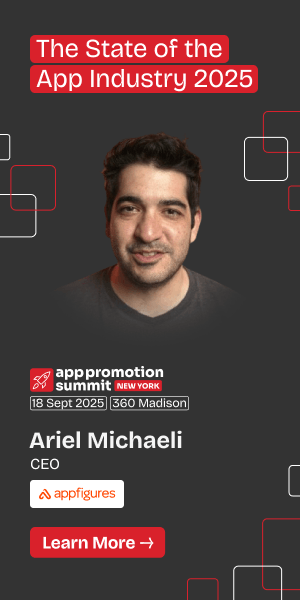At App Promotion Summit London 2025, FinTech marketers gathered to explore the challenges of driving growth, meeting regulatory demands, and maintaining user retention. In a high-stakes vertical where every download comes with a demand for trust, the panel offered practical insights into how today’s most agile FinTech apps are building loyal audiences in complex markets.
Moderated by mobile industry veteran David Murphy, the panel featured two standout voices:
- Alexa Coleridge Cole, Senior Product Marketing Manager (Mobile), Xero
- Georgina Andrews, Head of Product and Performance Marketing, Kuda
The conversation was packed with rich, practical insights that any app marketer in FinTech or beyond can learn from.
The challenge of simplifying complexity
Finance is intimidating, explained Alexa, especially for small business owners who don’t have a financial background.
Xero, traditionally a web-first accounting software, has been putting more of a focus on mobile. The goal was to make complex tasks manageable on the go. With sole traders and tradespeople as one of its core audiences, mobile access needed to feel like having all your business finances in your pocket, not another job.
The key challenge? Simplify without oversimplifying. Financial tasks are inherently complex, but Xero’s product and marketing teams have worked to strip away friction without removing meaningful control. That principle drove their rollout of in-app onboarding this year. Users can now sign up directly from mobile, a significant shift from their previous web-first flow.
The company also encourages users to provide feedback and vote on feature requests via a public Product Ideas Portal, a democratic approach that helps guide its mobile roadmap. This feedback loop grounds simplification in real-world need, not assumption.
Regulation: Constraint or strategic advantage?
Regulation can often slow things down, explained Georgina Andrews. Particularly in a market like Nigeria, where ad creatives must use Nigerian actors. Every message and asset needs compliance sign-off, and that takes time. But this has also made the company more methodical.
At Kuda, regulatory friction has forced the team to build tighter workflows, invest in forward planning, and develop hyper-local strategies that resonate authentically with the market. Compliance isn’t treated as an afterthought; rather, it’s a core part of campaign architecture.
Understand user expectations and privacy trends to monetize efficiently
Discover how 4,000 users view ads and data sharing, explore new tactics to boost ad revenue and retention, and learn from industry leaders how top apps turn privacy shifts into profit.
Find out moreA similar mindset drives strategy at Xero. As a global company operating in markets like Australia, New Zealand, the UK, and the US, regional nuance is non-negotiable. Regulations vary, and so do tones, triggers, and cultural sensitivities. Xero’s answer: value-based messaging. Rather than leaning on financial claims that may trigger red flags, their campaigns focus on outcomes, confidence, and user empowerment.
Onboarding: Keeping users moving
Onboarding is where intent meets friction — and whether users push through or drop off often comes down to the tiniest details.
At Kuda, onboarding is designed as a progressive trust-building journey, not a single gate. Their three-tier KYC (Know Your Customer) system allows users to start transacting after the first verification step. As users approach transactional limits, the app triggers smart nudges — behavioral prompts that encourage them to unlock higher tiers of verification at the moment of need.
If everything is frontloaded during onboarding, people tend to drop off, as Georgina explained. However, when users reach a limit first, they’re more motivated to move forward.
Meanwhile, Xero recently launched mobile onboarding on Android and overhauled its iOS onboarding, marking a major shift from its web-first legacy. For a product as critical and sticky as accounting software, convincing users to complete onboarding is a matter of trust.
Promotions help get users over the line, but Xero leans heavily on message testing: tones, structures, and triggers are all optimized to minimize drop-off. Trust cues, clarity, and perceived value carry more weight than hard-selling.
Trust is not a one-time event
As we notes just a few line ago, trust underpins everything in FinTech. As Alexa put it, users are effectively being asked to hand over control of their business finances or salary, which makes credibility and confidence non-negotiable.
At Xero, trust is built through a well-established ecosystem of partners, including government bodies, banks like Monzo, and crucially, a highly engaged network of accountants and bookkeepers. These professionals often act as de facto influencers, helping validate the product to potential users through their own endorsement.
Kuda, on the other hand, leans into social proof and user celebration. The team highlights individual achievements — like anniversaries or transaction milestones — and encourages users to share them through social channels. One of the most impactful campaigns has been the app’s year-end spending summaries, which generate organic buzz and reinforce transparency.
Even small, often-overlooked assets serve to reinforce trust. From app store screenshots to release notes, Xero has found that users do read the fine print. In fact, Alexa noted that customers frequently repeat language from release notes in their reviews.
UA strategy: Intent over volume
For both Xero and Kuda, user acquisition isn’t about sheer volume — it’s about attracting the right users and guiding them toward long-term value.
At Xero, Apple Search Ads currently deliver the strongest results. The platform’s high intent and reliable attribution make it ideal for reaching users actively seeking accounting tools. Xero also leverages custom product pages to tailor messaging to specific verticals — such as tradespeople or pet service providers — helping increase relevance and conversion.
Kuda, meanwhile, has found a surprising high performer in Snapchat. Despite perceptions that Snap’s user base might not align with serious financial behavior, the platform has consistently driven strong retention and lifetime value. In parallel, Meta campaigns using lookalike audiences have delivered strong ROI.
Both brands agreed that quality beats quantity and that effective UA depends on segmenting audiences and optimizing campaigns for lifecycle value, not just installs.
Tackling churn in a multi-app world
In today’s app ecosystem, loyalty is earned, not assumed, especially in FinTech, where switching costs are dropping and users often juggle multiple apps.
At Kuda, it’s normal for users to maintain two or three banking apps at once. The challenge? Becoming the primary financial app, the one users rely on daily. To support this, Kuda recently rolled out a rewards program that awards users with coins for everyday transactions. These coins can be used to unlock premium features like app customization and cashback, creating an incentive to consolidate financial activity within Kuda’s ecosystem.
At Xero, churn tends to spike after users take advantage of promotional offers. Many trial the software and then move on. In response, the team has been running experiments around messaging tone, offer duration, and post-trial follow-up content. Their retention strategy relies heavily on segmentation, tailoring content by vertical (e.g., trades, consultants) and lifecycle stage to increase relevance and stickiness.
In-app messaging as a retention engine
Both brands rely heavily on in-app messaging, leveraging it as a retention engine.
At Xero, in-app messages are used to deliver timely educational content, announce new features, and surface blog posts or help articles. The goal is to guide users with value, not distract them.
Kuda takes a similarly integrated approach, with a strong focus on media-rich experiences. The team has built video “reels” directly into the app, delivering tutorials, product updates, and light, entertaining content that keeps users informed and engaged without relying on external channels.
Both brands are also acutely aware of the balance between visibility and usability. Full-screen takeovers can grab attention but risk disrupting the core task (e.g., sending an invoice or completing a transfer). That’s why both teams invest in extensive testing around format, timing, and segmentation. The message must match the moment, Alexa and Georgina agreed.
Data: The backbone of personalization
Behind every relevant message and timely nudge is a well-oiled data infrastructure. Because personalization only works when your backend is built for it. Without data, personalization is just guessing
At Kuda, the marketing and growth teams connect their customer data platform (Segment) directly to a centralized data warehouse. Tools like CleverTap are then used for customer engagement. This setup supports detailed personalization: for example, sending low balance alerts at the right time.
Xero, meanwhile, builds detailed user profiles from the moment of acquisition. By capturing attributes like acquisition channel, business size, industry, and in-app behavior, the team can determine which features to highlight, which messages to surface, and which educational resources to deliver.
AI: Scaling Personalization and Simplicity
AI isn’t just for customer support anymore. It’s becoming a front-line driver of user experience and personalization.
Kuda is piloting an AI-powered tool that automatically generates and tests variations of in-app and push messaging. The system continuously optimizes based on real-time engagement metrics like open rates and tap-throughs. Early results are promising, showing measurable improvements in push notification performance without requiring manual iteration.
Xero, on the other hand, is exploring AI from a different angle, aiming to leverage it for product utility itself. The company recently launched Jax, an AI-powered business companion designed to help small business users handle complex financial tasks with ease. At Xero, AI is all about simplifying the complex, as Alexa put it.
Final thoughts: Product-led growth meets human insight
One of the clearest themes to emerge from the panel is that FinTech growth doesn’t belong to marketing alone. Growth that lasts depends on proactive collaboration across product, performance, UX, and customer success.
Product, trust, and performance can’t operate in silos. Every user touchpoint — from onboarding to app updates to education — needs to reflect value, clarity, and credibility. The result is a user journey that feels less like a funnel and more like a relationship.
As AppsFlyer’s Nidhi Singh put it earlier in the day: “Installs get you through the door. Engagement gets you a seat at the table.”
For FinTech apps like Xero and Kuda, growth is not just a matter of acquisition or automation, it’s about staying relevant in the daily financial lives of their users and proving that value again and again.













